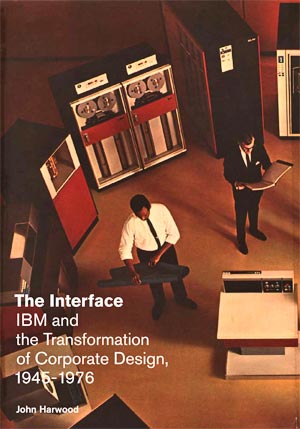
In 1956 the president of IBM, Thomas Watson Jr., hired the industrial designer and architect Eliot Noyes, charging him with reinventing IBM’s corporate image at every level, from the logo to products to buildings and beyond. The Interface tells this story in full for the first time, showing how Noyes and his fellow consultants (Charles Eames, Paul Rand, George Nelson, Edgar Kaufmann Jr., and a host of architects from around the world) remade IBM in a way that went well beyond this particular corporation—to transform the relationships between design, computer science, and corporate culture.
This history is more significant than a mere “case study.” It is a determining case.
IBM was the largest business machine corporation in the world; by the 1960s it was the size, in capital and employees, of Portugal and Norway combined. As such, it completely dominated the market for computers. Its products—and the new mode of managerial and logistical practice that came with them—impacted nearly every sphere of cultural endeavor from politics to art to science. As its executives were fond of saying, “IBM is a business whose business is how other businesses do business.”
Thus designers themselves were hardly unaffected by the insertion of the computer into manifold aspects of everyday life. I show how, in the period stretching from the “invention” of the computer just before and during WWII to the appearance of the personal computer in the mid-1970s, disciplines once well outside the realm of architecture—information and management theory, cybernetics, ergonomics, computer science—became integral aspects of design theory and practice.
The Interface is organized according to media—which are the “interfaces” through which the corporation appears as part of the world. It moves upward and outward in scale. Beginning with IBM’s graphics, it then moves to consider its products, architecture, multinational expansion, and its films and spectacles. In doing so, the book provides the first critical history of the industrial design of the computer, of Eliot Noyes’s influential career, and of some of the most important and long-forgotten work of the Office of Charles and Ray Eames.
The Interface is an attempt to explain how computing became an essential aspect of everyday life. This wasn’t always the case, and it wasn’t always certain that it would be.
Since Edmund C. Berkeley published his heady exposé Giant Brains, or Machines that Think, in 1949, and in scientific writing (whether fact or fiction) well before then, the specter of a machine that could mimic the activity of the human mind had haunted experts and laypersons alike. Fear and doubt reigned supreme: of unbridled technocracy, of “depersonalization,” automation, and, above all, of the possible threat that the computer presented to a received humanist tradition (Can a machine be said to “think”? And if so, does it think “better” than a human being?). In short, the world once wondered: What would a computerized world look like?
IBM addressed this anxiety in numerous ways, but it was not successful in allaying these fears until it embarked upon its sustained engagement with design as a means of convincing the public of the efficacy and wonder of its machines. It was not until the company’s managers realized that creating a mass market for computers was a problem of visuality, space, and experience—that is, an aesthetic problem—that they made any headway with skeptics.
IBM’s designers—particularly Eliot Noyes, Paul Rand, and Charles Eames—performed the crucial work of naturalizing the computer. This involved understanding the full sweep of natural and applied sciences being rapidly redefined in the post-WWII era, and then representing that discourse through every medium at the designers’ disposal. Crucially, this involved an intentionally paradoxical pair of claims: first, that the computer was a “tool” like any other, wholly natural and conventional; and second, that the computer was a magical device that would wholly transform every aspect of human life.
This may seem like a rather odd subject for an art and architectural historian. However, I have always been interested in the intersections between architecture, science, and economics. Far from viewing architecture as a helpless discipline, subject to the whims of the market, I claim that architecture has a vital role in articulating the fundamental visual and material aspects of our world.
I’d like to imagine that a reader picking up this book might be able to flip to the chapter that addresses a particular medium that interests them—e.g. graphics, industrial design, architecture, film and spectacle—and be surprised by the impact that IBM and its designers had upon that medium. (And then go to the check-out counter, then to their favorite reading spot, and then reopen the book to page one!) The book is full of a particular kind of uncanny history: nearly invisible things that seem familiar, natural, and inevitable are suddenly revealed to have a strange and unsettling history.
A good example of this is in the chapter on the design of computers: “Computer Architectures.” There I show that, until Eliot Noyes and Edgar Kaufmann Jr. had spent years thinking through how a computer ought to be designed as a material object in architectural space, there was quite literally no understanding of what we today call a computer interface.
Through a process of close collaboration with IBM’s various engineers, and a series of trials and errors, Noyes and Kaufmann eventually arrived at a specifically architectural understanding of the relationship between human beings and computers. They called it the “parlor and coal cellar” principle. The space that the computer operator inhabited, the parlor, was to be a space designed for the comfort and safety of the human being; the messy, even poisonous, space that the CPU itself inhabited, was to be relegated to the coal cellar, an essential functional component kept out of sight and touch from the operator. The hinge between these two spaces was the computer interface, which carefully and deliberately controlled the interaction between human being and machine.
This is what an interface is, a machine for bringing people and machines together into a productive apparatus, which is known as the “man-machine system.” Interfaces are the hyphen.
I have several hopes for this book, but the most dear is that it will contribute to a growing and increasingly sophisticated interdisciplinary discourse on the significance of technics in contemporary life. Art and architectural history have much to contribute to this discourse, since their fundamental sphere of inquiry—the visual and the spatial realms—are wholly constitutive of the mass media society in which we live.
I also hope that this book succeeds in another area, which is to prompt readers to think about the single most dominant form of social organization today—the corporation—in a nuanced way.
The corporation is a phenomenon that has long eluded serious thought. Art history can provide a concrete history of the otherwise abstract corporation by revealing and critiquing the real and material effects of the corporation in the world, and help us to avoid the vicious circular reasoning that so often appears as soon as one slips into abstraction.
As I write in the conclusion, “Virtual Paradoxes”: “It is my hope that an expanding critical art history of the computerization of art, design, and architecture—one that is the product of multiple historians and theorists in dialogue, one that sheds light on the ideologies inherent to the vague metaphorics of systems, networks, and interfaces even as it seeks to describe these phenomena—may help to avoid our being held hostage in the whimsical oxymoron and epistemological trap of ‘virtual reality.’”


John Harwood is Associate Professor of Art for Modern and Contemporary Architectural History at Oberlin College. He is also currently a Visiting Associate Professor in the School of Architecture at Princeton University. His writing has appeared in Grey Room, do.co.mo.mo, the Journal of the Society of Architectural Historians, and AA Files. Harwood is also a member of the architectural history collaborative Aggregate, whose first book, Governing by Design: Architecture, Economy and Politics in the 20th Century appears this month (April 2012) from the University of Pittsburgh Press.